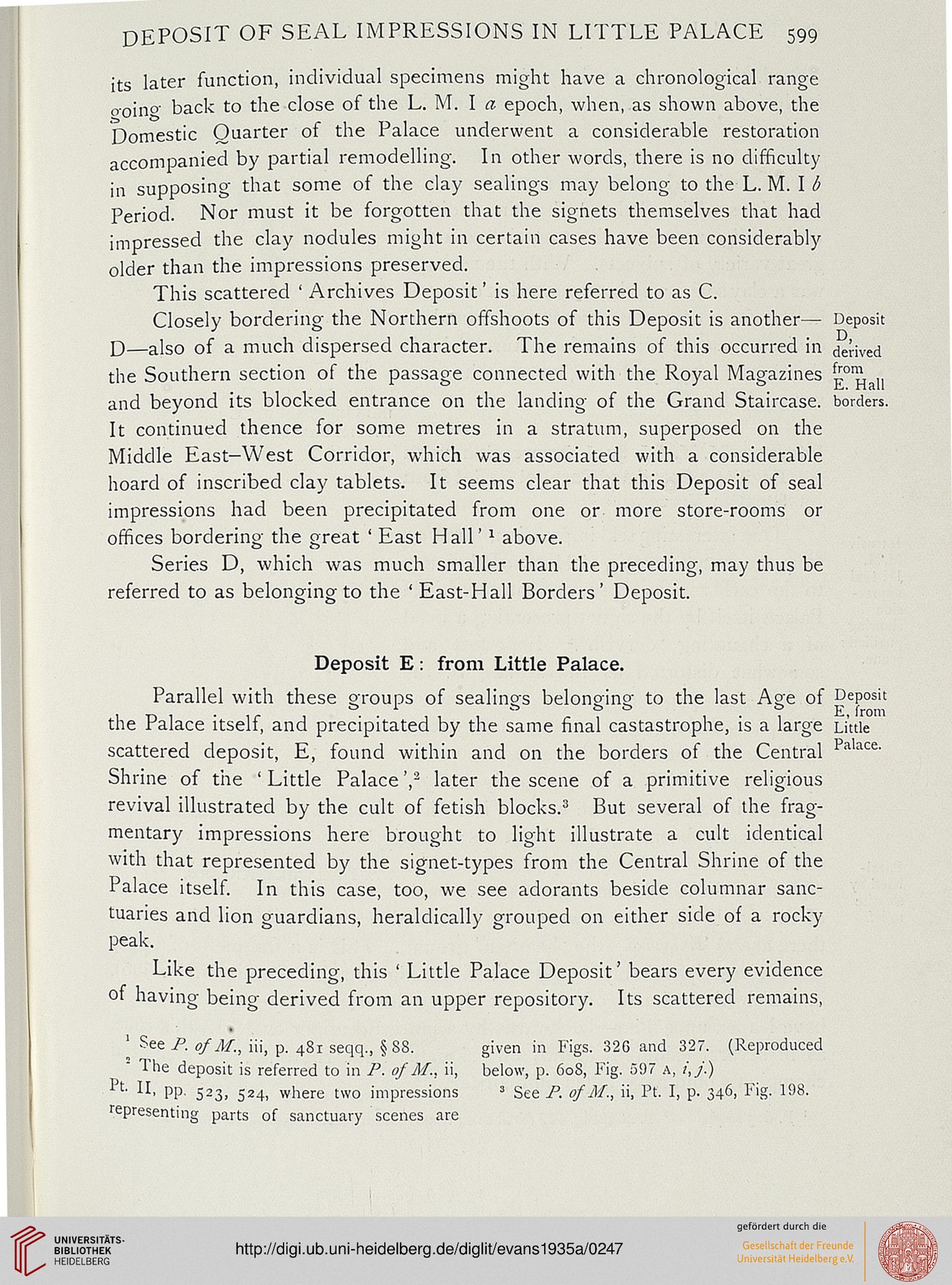DEPOSIT OF SEAL IMPRESSIONS IN LITTLE PALACE 599
its later function, individual specimens might have a chronological range
ooin°' back to the close of the L. M. I a epoch, when, as shown above, the
Domestic Quarter of the Palace underwent a considerable restoration
accompanied by partial remodelling. In other words, there is no difficulty
in supposing that some of the clay sealings may belong to the L. M. I 6
Period. Nor must it be forgotten that the signets themselves that had
impressed the clay nodules might in certain cases have been considerably
older than the impressions preserved.
This scattered ' Archives Deposit' is here referred to as C.
Closely bordering the Northern offshoots of this Deposit is another— Deposit
D—also of a much dispersed character. The remains of this occurred in derived
the Southern section of the passage connected with the Royal Magazines 5?™ ..
and beyond its blocked entrance on the landing of the Grand Staircase, borders.
It continued thence for some metres in a stratum, superposed on the
Middle East-West Corridor, which was associated with a considerable
hoard of inscribed clay tablets. It seems clear that this Deposit of seal
impressions had been precipitated from one or more store-rooms or
offices bordering the great ' East Hall' * above.
Series D, which was much smaller than the preceding, may thus be
referred to as belonging to the 'East-Hall Borders' Deposit.
Deposit E: from Little Palace.
Parallel with these groups of sealings belonging to the last Age of Deposit
to & & fc> E, from
the Palace itself, and precipitated by the same final castastrophe, is a large Little
scattered deposit, E, found within and on the borders of the Central Palace-
Shrine of the 'Little Palace',2 later the scene of a primitive religious
revival illustrated by the cult of fetish blocks.3 But several of the frag-
mentary impressions here brought to light illustrate a cult identical
with that represented by the signet-types from the Central Shrine of the
Palace itself. In this case, too, we see adorants beside columnar sanc-
tuaries and lion guardians, heraldically grouped on either side of a rocky
peak.
Like the preceding, this ' Little Palace Deposit' bears every evidence
of having being derived from an upper repository. Its scattered remains,
See P. of M.t iii, p. 481 seqq., § 88. given in Figs. 320 and 327. (Reproduced
" The deposit is referred to in P. of M., ii, below, p. 60S, Fig. 3D" a, i,j.)
' U' PP- 523, 524, where two impressions s See P. of M., ii, Ft. I, p. 346, Fig. 198.
representing parts of sanctuary scenes are
its later function, individual specimens might have a chronological range
ooin°' back to the close of the L. M. I a epoch, when, as shown above, the
Domestic Quarter of the Palace underwent a considerable restoration
accompanied by partial remodelling. In other words, there is no difficulty
in supposing that some of the clay sealings may belong to the L. M. I 6
Period. Nor must it be forgotten that the signets themselves that had
impressed the clay nodules might in certain cases have been considerably
older than the impressions preserved.
This scattered ' Archives Deposit' is here referred to as C.
Closely bordering the Northern offshoots of this Deposit is another— Deposit
D—also of a much dispersed character. The remains of this occurred in derived
the Southern section of the passage connected with the Royal Magazines 5?™ ..
and beyond its blocked entrance on the landing of the Grand Staircase, borders.
It continued thence for some metres in a stratum, superposed on the
Middle East-West Corridor, which was associated with a considerable
hoard of inscribed clay tablets. It seems clear that this Deposit of seal
impressions had been precipitated from one or more store-rooms or
offices bordering the great ' East Hall' * above.
Series D, which was much smaller than the preceding, may thus be
referred to as belonging to the 'East-Hall Borders' Deposit.
Deposit E: from Little Palace.
Parallel with these groups of sealings belonging to the last Age of Deposit
to & & fc> E, from
the Palace itself, and precipitated by the same final castastrophe, is a large Little
scattered deposit, E, found within and on the borders of the Central Palace-
Shrine of the 'Little Palace',2 later the scene of a primitive religious
revival illustrated by the cult of fetish blocks.3 But several of the frag-
mentary impressions here brought to light illustrate a cult identical
with that represented by the signet-types from the Central Shrine of the
Palace itself. In this case, too, we see adorants beside columnar sanc-
tuaries and lion guardians, heraldically grouped on either side of a rocky
peak.
Like the preceding, this ' Little Palace Deposit' bears every evidence
of having being derived from an upper repository. Its scattered remains,
See P. of M.t iii, p. 481 seqq., § 88. given in Figs. 320 and 327. (Reproduced
" The deposit is referred to in P. of M., ii, below, p. 60S, Fig. 3D" a, i,j.)
' U' PP- 523, 524, where two impressions s See P. of M., ii, Ft. I, p. 346, Fig. 198.
representing parts of sanctuary scenes are





